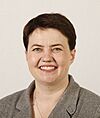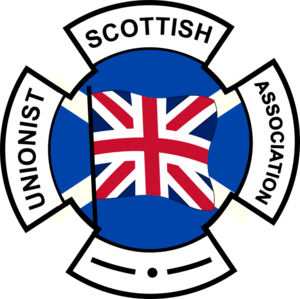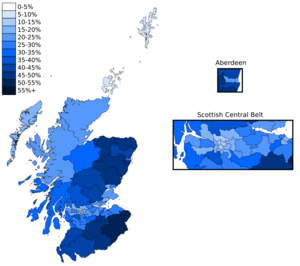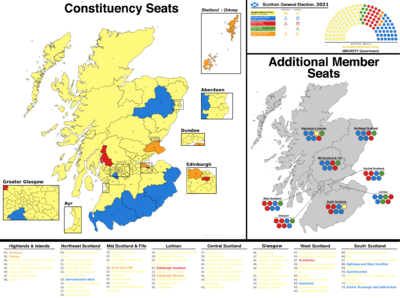Scottish Conservatives facts for kids
Quick facts for kids
Scottish Conservative and Unionist Party
Pàrtaidh Tòraidheach na h-Alba
|
|
|---|---|
 |
|
| Leader | Russell Findlay |
| Deputy Leader | Rachael Hamilton |
| Chair | Alasdair Locke |
| Founded | April 1965 |
| Preceded by | Unionist Party |
| Headquarters | 67 Northumberland Street, Edinburgh |
| Youth wing | Scottish Young Conservatives |
| Membership (2024) | 7,000 |
| Ideology |
|
| Political position | Centre-right to right-wing |
| National affiliation | Conservatives |
| Colours | Blue |
| House of Commons (Scottish seats) |
5 / 57
|
| Scottish Parliament |
30 / 129
|
| Local government in Scotland |
181 / 1,226
|
| Councils led in Scotland |
4 / 32
|
The Scottish Conservative and Unionist Party, often called the Scottish Tories, is a major political party in Scotland. It is the Scottish part of the main Conservative Party in the United Kingdom.
The party's main beliefs are conservatism and unionism. This means they support traditional values and want Scotland to remain part of the United Kingdom. In the Scottish Parliament, they are the second-largest party and the main opposition.
The party takes part in elections for the UK Parliament, the Scottish Parliament, and local councils across Scotland. The current leader of the party is Russell Findlay, who was elected in September 2024.
Contents
History of the Party
The party has changed a lot over the years. Its story can be broken down into a few key periods.
Early Years and the Unionist Party
Before 1912, the Conservative Party in Scotland was separate. In 1912, it merged with another group called the Liberal Unionists. They formed a new party called the Unionist Party.
This party was very successful for many years. In the general elections of 1931 and 1955, it won more than half of all votes in Scotland. This was a huge achievement. During this time, two Prime Ministers from the Unionist Party, Bonar Law and Alec Douglas-Home, led the UK.
A New Name and Tough Times
In 1965, the Scottish Unionist Party officially joined with the Conservative Party in England and Wales. It became the Scottish Conservative and Unionist Party, the name it still has today.
After this change, the party's popularity began to fall. The 1980s were a difficult time for the party in Scotland. The lowest point came in the 1997 UK general election, when the party lost all of its Scottish seats in the House of Commons.
Devolution and the Scottish Parliament
In 1997, the people of Scotland voted for devolution. This meant creating a new Scottish Parliament with powers to make laws on certain issues like health and education.
The first election for the Scottish Parliament was in 1999. The Scottish Conservatives won 18 seats. This gave the party a new platform in Scottish politics after its losses in the UK parliament.
In the 2016 Scottish Parliament election, the party had a major success. Under the leadership of Ruth Davidson, they won 31 seats. This made them the second-largest party in the Scottish Parliament, ahead of Scottish Labour. They kept this position in the 2021 election.
Recent Elections
Here is how the party has performed in some recent elections.
2017 UK General Election
The party had its best result in many years at the 2017 UK general election. They won 13 of Scotland's 59 seats in the House of Commons. This was a big increase from the single seat they had held since 2001.
A key part of their campaign was opposing a second referendum on Scottish independence. They won seats across Scotland, including in the North East and the Scottish Borders.
2019 UK General Election
The 2019 general election was more difficult for the party. They lost more than half of their Scottish seats, dropping from 13 to 6. The Scottish National Party (SNP) won most of the seats that the Conservatives lost.
2021 Scottish Parliament Election
Douglas Ross led the party into the 2021 Scottish Parliament election. The party's campaign focused on rebuilding Scotland's economy after the COVID-19 pandemic and opposing another independence referendum.
The party won 31 seats, the same number as in 2016. This result meant they remained the second-largest party and the main opposition to the SNP government at Holyrood, the home of the Scottish Parliament.
What the Party Believes In
The Scottish Conservatives are a centre-right party. This means they generally support business, individual freedom, and a smaller role for the government in the economy.
Their two main principles are:
- Conservatism: They believe in traditional values, strong communities, and law and order.
- Unionism: They strongly believe that Scotland should stay a part of the United Kingdom. They are against Scottish independence.
In Scotland, the party has its own policies for areas where the Scottish Parliament has power. For example, they have supported policies like increasing funding for the police and building more affordable homes. They often argue for lower taxes than other parties to help businesses grow.
How the Party is Organized
The party has a structure for making decisions and running campaigns.
- The Leader is the most senior person in the party. They are elected by party members. The current leader is Russell Findlay.
- The Deputy Leader supports the leader. This role is held by Rachael Hamilton.
- The Party Chairman, currently Alasdair Locke, runs the party's management board.
- The party's main office is in Edinburgh.
Leaders of the Scottish Conservative Party
The role of a single, overall leader for the Scottish party was created in 2011.
| No. | Portrait | Name | Term start | Term end |
|---|---|---|---|---|
| 1 |  |
Ruth Davidson | 4 November 2011 | 29 August 2019 |
| 2 |  |
Jackson Carlaw | 14 February 2020 | 30 July 2020 |
| 3 |  |
Douglas Ross | 5 August 2020 | 27 September 2024 |
| 4 |  |
Russell Findlay | 27 September 2024 | Incumbent |
Images for kids
See also
- Scottish Unionist Party (1912–1965)
- Elections in Scotland
- Welsh Conservatives







